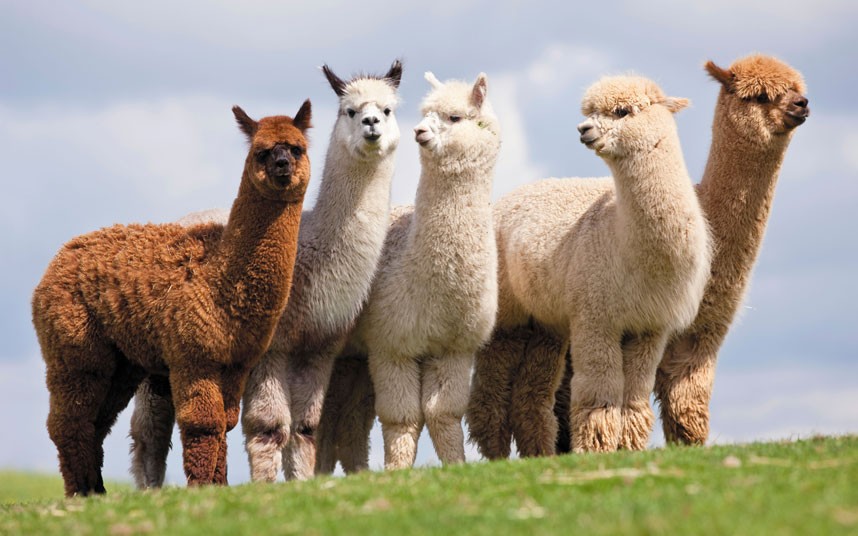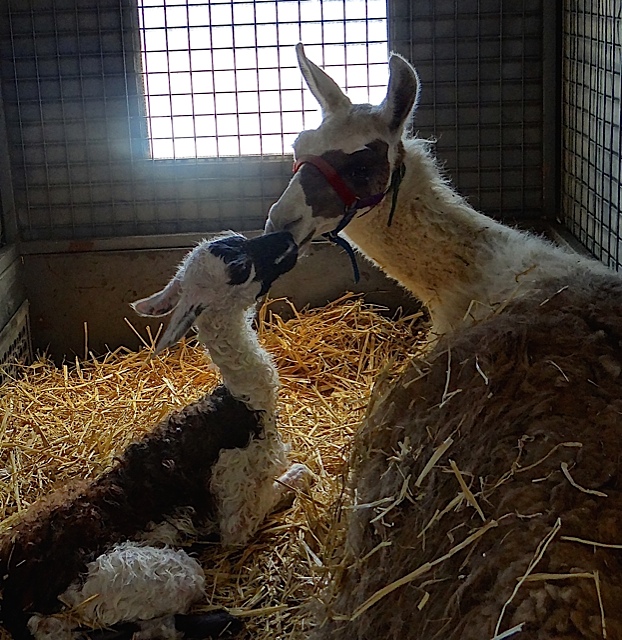 Since the late 1990s, the Crookwell district has seen a steady influx of alpacas and llamas.
Since the late 1990s, the Crookwell district has seen a steady influx of alpacas and llamas.
Alpacas in particular have become an important and valued part of Crookwell Veterinary Hospital’s day-to-day practice. Our vets love working with alpacas – they are gentle and amenable to handling (only the occasional individual spits!), and they’re incredibly tough and resilient in the face of pain and illness.
Alpacas are one of four members of the South American camelid species: alpacas, llamas, vicunas and guanacos. The camelid family also includes the Bactrian and Dromedary camels from Asia and Africa.
The history of their introduction into Australia (first in the mid-1800s then, officially, in the late 1980s) reads like a Boy’s Own adventure – click here to discover the story.
The alpaca industry in Australia is primarily focused on the species’ luxurious, soft fleece.
As well, individual wethers are increasingly being used as protectors and guardians of sheep flocks, and a small meat industry is being developed – alpaca meat is high in protein and low in fat.
Differences and similarities to ruminants
Alpacas originated in South America and can live 15 to 20 years. Baby alpacas are called crias, teenagers are tuis, adult females hembras and males, machos. There are two types of alpacas, Huacaya (the most common Australian alpaca) and Suri, differentiated mainly by their fleece – the fleece of Huacayas is naturally crimped, while the Suri has long, silky locks.
Impact on the environment
Alpacas are the most environmentally friendly domesticated livestock species in Australia. Instead of hooves, they have soft-padded feet, each with two relatively soft toenails that exert a ground foot pressure of 39kPA. Compare this to sheep (82kPA) and cattle (185kPA). Even the kangaroo at 46kPA exerts more pressure on Australia’s often fragile environment.
Digestive tract and nutrition
Ruminants (sheep, cattle, goats) have four stomachs, alpacas have three. Adapted to a high fibre diet, alpacas are primarily grazers and eat around 2% of their body weight daily. While they prefer high quality, short pastures they are highly adaptable grazers in dry periods and it’s estimated they are up to 30% more efficient grazers than sheep and goats. Their DSE is similar or better, despite being significantly heavier than sheep (females average 70kg, males 85kg).
Why do alpacas perform better than sheep on poor forage? Studies have shown that food matter takes significantly longer to pass through the alpaca’s three stomachs so gut microbes have longer to work on the ingested carbohydrates. They also produce more saliva to aid in digestion, and are very efficient recyclers of urea – this means they can thrive on protein levels of only 10 to 12%.
Unlike cattle, they are resistant to bloat and, as well as the difference in stomachs to ruminants, the lips of alpacas are quite unique. The upper lip is split, allowing each side of the lip to move independently and the alpaca to be selective about its choice of food. Alpacas don’t use their tongue to grasp food as, for example, cattle do and they can’t lick to groom or lick mineral and other supplement blocks.
 Reproduction
Reproduction
Unlike the oestrus cycles of cattle and sheep that govern mating and breeding, alpacas are non-seasonal breeders and demonstrate year-round sexual activity, with prolonged periods when mating takes place. Ovulation is not spontaneous, and occurs as a result of mating.
Alpaca pregnancies last on average 342 days.
Image to the right shows a cria llama just born, with assistance, at Crookwell Veterinary Hospital (thanks to Rosie Francis of Maison Mauve Llamas and Alpacas at Taylors Flat, near Boorowa).
Preventative management
Vaccination
It’s essential alpacas receive the same protection as sheep and cattle against the following clostridial diseases: tetanus, blackleg, pulpy kidney, black disease and malignant oedema.
5in1 vaccination will provide the necessary immunity and CVH vets recommend using the same dose rate and vaccination schedule as for cattle.
Internal and external parasites
Alpacas are susceptible to cattle, goat and sheep intestinal parasites, in particular Barber’s Pole, Small Brown Stomach worm (Ostertagia), Black Scour Worm (Trichostrongylus) and liver fluke (they prefer grazing in moist, low areas). Alpacas urinate and defaecate in specific areas and then avoid these while grazing. This helps minimise exposure to worm eggs but remember – if alpacas are grazed with sheep, cattle or goats they will ingest worm eggs from elsewhere in the paddock.
Note there are currently no drenches available that are registered for use in alpacas. Please contact us and speak with our vets – the use of sheep drenches in alpacas is permissible, but only under the direction of a veterinarian. It’s essential alpaca owners discuss with a veterinarian the dose rates and administration relevant to their flock.
As in sheep, CVH recommends the routine use of alpaca faecal egg counts to monitor worm burdens and drench efficacy – drench resistance is common in sheep and it is already being diagnosed in alpaca flocks.
Alpacas have their own lice species – seek veterinary advice if you suspect your flock has an infestation. Fly strike generally doesn’t occur in alpacas and mulesing is not required. Alpacas don’t grow hair fibres in the perianal area and their fleece is not greasy as is sheep wool. Their method of urinating and defaecating – by crouching – also keeps this area clean.
Vitamin D deficiency
This is one condition more commonly seen in alpacas than in other livestock. Hypotheses include the alpaca’s thick coat with little to no exposed skin, insufficient exposure to UV light when located south of latitude 34°S during winter in Australia, or in animals that are housed indoors.
Vitamin D is critical in maintaining circulating levels of calcium and is essential for healthy bone growth. Deficiency in young growing animals can lead to rickets (milk does not contain vitamin D).
Vitamin D supplementation (by injection), especially during the winter months, is a routine part of alpaca and llama management in the Crookwell district. Note that excess Vitamin D can cause serious, even fatal, toxicity – speak first with CVH vets about the need for supplementation in your situation, the best available products and the correct dose rates.
Shearing
Alpacas need to be shorn annually. One of the issues that’s been examined by AWEX (the Australian Wool Exchange) is the possibility of cross contamination of alpaca and sheep fibres when alpacas are run with sheep (for example, as guard animals).
According to the Australian Alpaca Association, AWEX accept the running of both species together and the shearing of alpacas in shearing sheds, but recommend best practice guidelines that minimise the risk of contamination: separate alpacas from sheep before yarding and shearing (separation 8 weeks before shearing is recommended) and shear alpacas after all sheep are shorn and the shed is cleaned.
The Australian Alpaca Association website has a list of shearers specialising in alpacas.
Acknowledgements: information for this article has been drawn from a number of sources, in particular the fact sheets on the Australian Alpaca Association website.